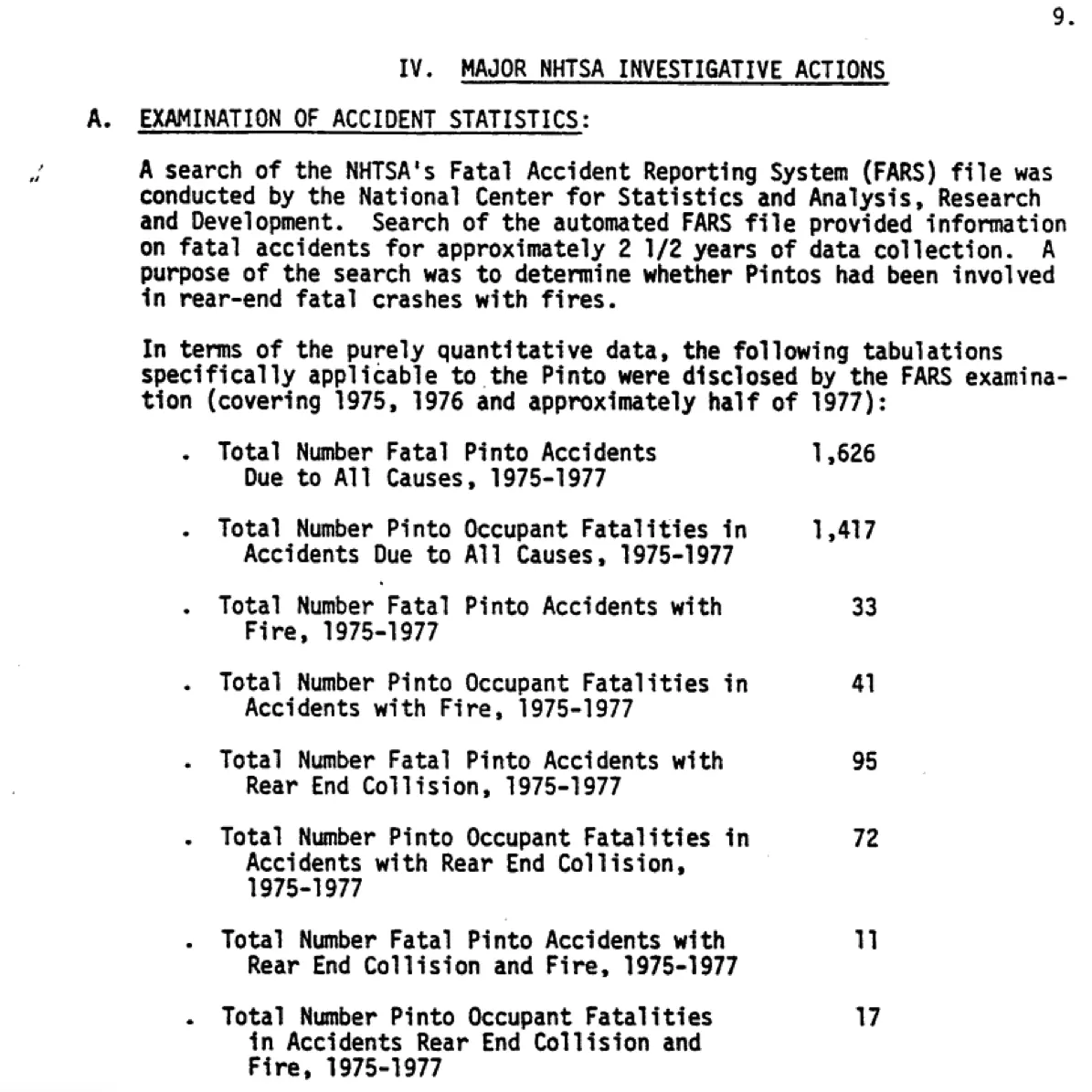It’s just the latest reason to be skeptical of the car’s safety record.
The podcast You’re Wrong About did an episode about the Pinto. Spoiler alert: wasn’t that unsafe. If you listen to podcasts, you know how to find the episode. If not, here’s the YouTube mirror https://youtu.be/52pPcMwM6Wc
They look like robot shit
the pinto data is quite remarkably cherry picked (1626 deaths in 2.5 years):

(sauce: https://www.autosafety.org/wp-content/uploads/import/ODIPinto.pdf Page 9.)
deleted by creator
Swastitruck
especially if one paints “die nazi scum” on the windshield
a fatality rate of 14.5 percent per 100,000 units.
Tell me you don’t understand statistics without telling me you don’t understand statistics.
It’s clear they meant “14.5 per 100,000 units” because later they call that “17 times” the Ford Pinto’s fatality rate of “0.85 per 100,000 units”. 14.5 divided by 0.85 is 17.06, so very close to “17 times.”
But that “percent” is just randomly thrown in there and is largely meaningless.
(Taking it as literally as it could possibly be taken, one could say it meant “0.145 per 100,000 units”. But again, from the context in the rest of the article, it’s clear that’s not what they meant as that’s not “17 times” 0.85.)
the approximately 34,000 Cybertrucks on the roads had five fire fatalities
-
They sold millions of Pintos. Sample size is important.
-
They included the guy who shot himself and then blew up the truck. That had nothing to do with the truck. That one death made up 20% of their fatalities.
-
The other 3 victims were all in the same vehicle, in the same crash, which means these 4 deaths were comprised of 2 incidents. Name another production car that hasn’t had at least 2 collisions that resulted in a fire fatality.
Bad journalism is bad.
Ok, so instead of the Cybertruck being 17 times deadlier than the Ford Pinto, it’s only 13.6 times deadlier. Wow, thanks for pointing this out.
See 1. I’d venture a guess that the first 34k Pintos had a much higher fatality rate than the >1M ones.
Source?
Source https://www.autosafety.org/wp-content/uploads/import/ODIPinto.pdf Page 9.
@[email protected] is absolutely correct
Can you point out specifically where it says that the first 34k pintos had a higher fatality rate? I read page 9 and didn’t see it.
Pintos had an over two orders of magnitude higher mortality rate then the numbers used in the original “analysis“. The rest of this is moot.
You want a source for my guess? It’s just basic and logic and reason that would lead one to deduce that they probably were working to fix the people dying problem, and issued fixes as they went along.
deleted by creator
That was the basis for the Tyler Durden character in Fight Club.
No, you just made that up. The scene in Fight Club did not name a specific vehicle or brand. He says “my company” and the vehicle depicted in the scene is clearly not a Pinto.
Ford had to recall 1.5 million
And they sold >3M.
E: the user I’m replying to here made shit up, got called out, deleted their comments, started making shit up again, got called out again, deleted comments again. If I sound like a jerk, it’s because they were accusing me of the things they were doing and I just repeated their statements back to them verbatim.
deleted by creator
deleted by creator
He did not say “my company”:
BUSINESS WOMAN: … Which… car company do you work for?
JACK: A major one.
deleted by creator
It’s reported as the rate per 100,000 units. So that’s accounted for.
Bad commenting is bad.
- The total is 4. Thats the definition of a small sample.
the total sample is between 0 and 34,000 across the past couple years. You are mixing up sample, 34,000 is actually a remarkably large sample size.
Maybe you dont understand clustering
do enlighten me then.
I’d suggest you familiarize yourself with the concept of sample sizes.
So, Wikipedia says the Ford Pinto sold 3,173,491 units. This article says there were 27 Ford Pinto fatalities. The article also says the Cybertruck sold 34,000 units and there have been 5 fatalities.
Your point 2 aside, you’re not trying to argue that
(5/34,000) / (27/3,173,491)isn’t approximately 17, right?(Again, point 2 aside) is your point that 5 deaths (or rather 4 deaths if you don’t count the guy from point 2) out of 34,000 units isn’t a big enough sample size to draw conclusions and that you think it’s likely that as more units are sold, the rate won’t stay that high and over time the data will average out to a fatality rate less than that of the Ford Pinto?
One more question if I may. Are you a fan of Tesla?
you think it’s likely that as more units are sold, the rate won’t stay that high
That would be a prediction of the future that I’m not prepared to make, but I do suspect that will end up being the case. Assuming they ever even sell a million of them before ending production. All I will comment on is today, and the idea that the first 34k Pintos probably had a much higher fatality rate than the last 3,139,491.
Are you a fan of Tesla?
I’m a fan of rational thought processes and statistics. Something I think very few people are capable of when it comes to anything having to do with Musk. The fact that Elon’s name is even in the headline leads me to believe that’s the case here as well. When was the last time you heard about “Farley’s Ford” or “Rawlinson’s Lucid”? If you’re a “journalist”, you just can’t go wrong with anything to do with Elon.
Assuming they ever even sell a million of them before ending production.
You don’t think there’s anything magical about the number “a million”, though, correct? Just “enough to form a sufficiently good sample size” (whatever your threshold might be.)
Are you a fan of Tesla?
I’m a fan of rational thought processes and statistics…
I can’t help but notice you dodged my question.
You don’t think there’s anything magical about the number “a million”, though, correct?
Sure.
I can’t help but notice you dodged my question.
I didn’t dodge it, I chose not to engage because you’re looking to attack my character and derail the conversation rather than discussing the merit of my statements.
For those spending this much time explaining that an N=4 being statistically conclusive (LOL), perhaps your time would have been better used if you looked into how badly the pinto data was cherry picked (1626 deaths in 2.5 years):

(sauce: https://www.autosafety.org/wp-content/uploads/import/ODIPinto.pdf Page 9.)
Dude. I’ve taught statistics. I don’t think you understand what you’re arguing here. lol.
Why don’t you bring me up to speed instead of levying personal attacks and then disappearing?
I get paid to teach stats. So not my job here. But let me use common sense and see if that works.
Is a comparison valid? Of course it is. Connecticut has a population of about 3.5 million. Torrington CT has a population of around 35,000. Are you telling me that you can’t compare death rates in Torrington vs. the rest of Connecticut because of “statistics”?
You can compare whatever you want. But there are good comparisons and there are bad comparisons, and this is the latter.
Also we’re talking about cars that roll off an assembly line, not people. If the death rate is higher in people, do you blame the people? Another bad comparison.
What are you even talking about? Failure rates in manufacturing are governed by the same statistics rules as human errors or deaths for sufficiently large n. And 35,000 is sufficiently large n .
It’s a valid comparison and statistically sound.
-








